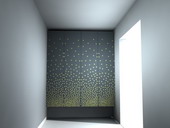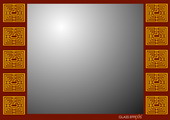Toughened or tempered glass is glass that has been processed by controlled thermal or chemical treatments to increase its strength compared with normal glass. Tempered glass is made by processes which create balanced internal stresses which give the glass strength.
 |
|
It will usually shatter into small fragments instead of sharp shards when broken, making it less likely to cause severe injury and deep lacerations. As a result of its safety and strength, |
Tempered glass is used in a variety of demanding applications, including passenger vehicle windows, glass doors and tables, as a component of bulletproof glass, for diving masks, and various types of plates and cookware.
Toughened glass is made from annealed glass via a thermal tempering process. The glass is placed onto a roller table, taking it through a furnace that heats it above its annealing point of about 720 °C. The glass is then rapidly cooled with forced air drafts while the inner portion remains free to flow for a short time.
 |
|
The term toughened glass is generally used to describe fully tempered glass but is sometimes used to describe heat strengthened glass as both types undergo a thermal 'toughening' process' |
There are two main types of heat treated glass, heat strengthened and fully tempered. Heat strengthened glass is twice as strong as annealed glass while fully tempered glass is typically four to six times the strength of annealed glass and withstands heating in microwave ovens.
The difference is the residual stress in the edge and glass surface. Fully tempered glass in the US is generally above 65 MPa while Heat Strengthened glass is between 40 and 55 MPa.
It is important to note that while the strength of the glass does not change the deflection, being stronger means that it can deflect more before breaking. Annealed glass deflects less than tempered glass under the same load, all else being equal.
ผลิตภัณฑ์กระจกตกแต่งอื่นๆ ของ บริษัท ดีดีเอสวี คอนเซ็ปท์ จำกัด











